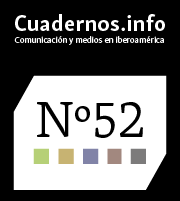El concepto de antihéroe o antiheroína en las narrativas audiovisuales transmedia
DOI:
https://doi.org/10.7764/cdi.52.34771Palabras clave:
antihéroes, héroes, narrativas audiovisuales, relatos transmedia, etnografía virtual, cultura popResumen
Este artículo estudia el concepto de antihéroe o de antiheroína, con énfasis en los personajes catalogados como tal en la cultura pop transmedia y su contraposición a los héroes y superhéroes clásicos y modernos. A partir de una revisión bibliográfica y teórica desde los orígenes del concepto hasta la actualidad, se condujo una etnografía virtual en Instagram para extrapolar los rasgos y atributos de los denominados antihéroes que protagonizan algunas de las narrativas audiovisuales transmedia contemporáneas de mayor éxito entre 2015 y 2021. Lo anterior, con el objetivo de proponer una definición actualizada del término y establecer unas características comunes que permitan arrojar luz ante la falta de criterio unificado y respecto de las diferentes perspectivas que lo abordan.
Descargas
Citas
Arbona, G. (2008). El acontecimiento como categoría del cuento contemporáneo (The Event as a Category of the Contemporary Short Story). Arco Libros.
Ardanaz, M. (1983). El antiheroísmo heroico (Heroic Antiheroism). In Asociación Española de Estudios Anglo-Norteamericanos (Ed.), Héroe y antihéroe en la literatura inglesa: actas del V congreso de AEDEAN (Hero and Antihero in English Literature: Proceedings of the 5th AEDEAN Congress) (pp. 79-89). Alhambra.
Bonnet, J. C. (2013). Diderot. Le Neveu de Rameau (Rameau's Nephew). Flammarion.
Brans, J. (1984). The Dialectic of Hero and Anti-Hero in Rameau’s Nephew and Dangling Man. Studies in the Novel, 16(4), 435-447. https://www.jstor.org/stable/29532311
Campbell, J. (2020). El héroe de las mil caras (The Hero With a Thousand Faces). Ediciones Atalanta.
Cappello, G. (2007). Configuración y tiempo del antihéroe (Antihero configuration and time). Contratexto, (016), 171-181. https://doi.org/10.26439/contratexto2008.n016.789
Dietz, B. (1983). Una tentativa épica en la poesía de C. Day Lewis (An Epic Attempt at the Poetry of C. Day Lewis). In Asociación Española de Estudios Anglo-Norteamericanos (Ed.), Héroe y antihéroe en la literatura inglesa: actas del V congreso de AEDEAN (Hero and Antihero in English Literature: Proceedings of the 5th AEDEAN Congress) (pp. 151-158). Alhambra.
Frye, N. (2006). Anatomy of Criticism: Four Essays. University of Toronto Press.
García, A. N. (2020). Placer estético y repugnancia en Hannibal: identificación dramática, prolongación temporal y puesta en escena (Aesthetic enjoyment and repugnance in Hannibal: character engagement, temporal prolongation and mise-en-scène). Cuardernos.Info, (44), 209-224. https://doi.org/10.7764/cdi.44.1556
García-Gual, C. (2017). Diccionario de mitos (Myths Dictionary). Turner.
García Peinado, M. Á. & Monferrer-Sala, J. P. (1998). De poesía y pornografía medievales (Of medieval poetry and pornography). Revista Complutense de Estudios Franceses, 13, 71-86.
Garfield, E. P. & Schulman, I. A. (1990). Las literaturas hispánicas (Hispanic Literatures). Wayne State University Press.
Gil, F. J. & García, F. (2016). Héroe claro y héroe oscuro en el relato cinematográfico (Clear Hero and Dark Hero in the Cinematographic Narration). Área Abierta, 16(3), 1-16. https://doi.org/10.5209/ARAB.53654
González-Sánchez, J. F. (2011). Héroes, antihéroes y villanos en el Western español (Heroes, Antiheroes, and Villains in the Spanish Western). Razón y Palabra, (78).
González-Escribano, J. L. (1981). Sobre los consejos de "héroe y antihéroe" en la Teoría de la Literatura (On the Advice of "Hero and Antihero" in the Literature Theory). Archivum, (31-32), 367-408.
Greenwood, D., Ribieras, A., & Clifton, A. (2021). The dark side of antiheroes: Antisocial tendencies and affinity for morally ambiguous characters. Psychology of Popular Media, 10(2), 165–177. https://doi.org/10.1037/ppm0000334
Gupta, R. (2021). A Stranger in the Crowd: Camus’ Meursault and His Antiheroic Traits. Academia Letters, 2989. https://doi.org/10.20935/AL2989
Linde, R. & Nevado, I. (2016). La evolución del personaje del villano en el cine español (1982–2015) (The evolution of the villain in Spanish cinema(1982-2015)). Comunicación y Medios, (33), 55-72. https://doi.org/10.5354/rcm.v0i33.39345
McKee, R. (2013). El guion. Sustancia, estructura, estilo y principios de la escritura de guiones (The Script. Substance, Structure, Style, and the Principles of Screenwriting). Alba.
Monte, A. (1971). Itinerario de la novela picaresca (Itinerary of the Picaresque Novel). Lumen.
Pavis, P. (1966). Diccionario del teatro (Theater Dictionary). Paidós.
Real Academia Española. (s.f.). Antihéroe (Antiheroe). In Diccionario de la Real Academia Española. Retrieved on May 5, 2020, from https://dle.rae.es/antih%C3%A9roe
Rico, D. A., Galindo, J. A., Maya, E., & Guerrero, R. F. (2019). El héroe oscuro y el antihéroe de la novela gráfica: Modelos éticos para los adolescentes en la complejidad contemporánea (The Graphic Novel’s Dark Hero and Antihero: Ethical Models for the Adolescents in Contemporary Complexity). Eureka. Revista de Investigación Científica en Psicología, 16(M), 137-158. https://psicoeureka.com.py/publicacion/16-2/articulo/18
Ruiz, M. & Contreras, A. (1979). Glosario de términos del arte teatral (Glossary of Theatrical Art Terms). Trillas.
Ruiz, M. R. & Aguirre, G. (2015). Etnografía virtual, un acercamiento al método y a sus aplicaciones (Virtual Ethnography, an Approach to the Method and its Applications). Estudios sobre las Culturas Contemporáneas, 21(41), 67-96. https://www.culturascontemporaneas.com/articulos.htm?revista=65
Sánchez-Escalonilla, A. (2002). Guión de aventura y forja de un héroe (Adventure Script and Forging of a Hero). Ariel.
Sosa, C. J. (2015). Teoría del antihéroe. Aproximación y análisis descriptivo de un concepto transversal para la narrativa policíaca contemporánea (Antihero Theory. Approach and Descriptive Analysis of a Transversal Concept for Contemporary Police Narrative). In J. Sánchez-Zapatero A. & Martín-Escribà (Eds.), El género eterno: estudios sobre novela y cine negro (The Eternal Genre: Studies on Novel and Film Noir) (pp. 53-60). Andavira Editora.
Schubert, Ch. (2017) Constructing the antihero: Linguistic characterisation in current American television series. Journal of Literary Semantics, 46(1), 25-46. https://doi.org/10.1515/jls-2017-0002
Vaage, M. B. (2015). The Antihero in American Television. Routledge. https://doi.org/10.4324/9781315715162
Valles, J., dir. (2002). Diccionario de Teoría de la Narrativa (Dictionary of Narrative Theory). Alhulia.
Vernant, J. P. (2000). El universo, los dioses, los hombres (The universe, the Gods, the Men). Anagrama.
Villegas, J. (1978). La estructura mítica del héroe en la novela del siglo XX (The Mythical Structure of the Hero in the Twentieth Century Novel). Planeta.
Vogler, C. (2020). El viaje del escritor (The Writer's Journey). Ma Non Troppo.
Descargas
Publicado
Cómo citar
Número
Sección
Licencia
Derechos de autor 2022 Alfonso Freire, Montserrat Vidal-Mestre

Esta obra está bajo una licencia internacional Creative Commons Atribución-NoComercial-CompartirIgual 4.0.















